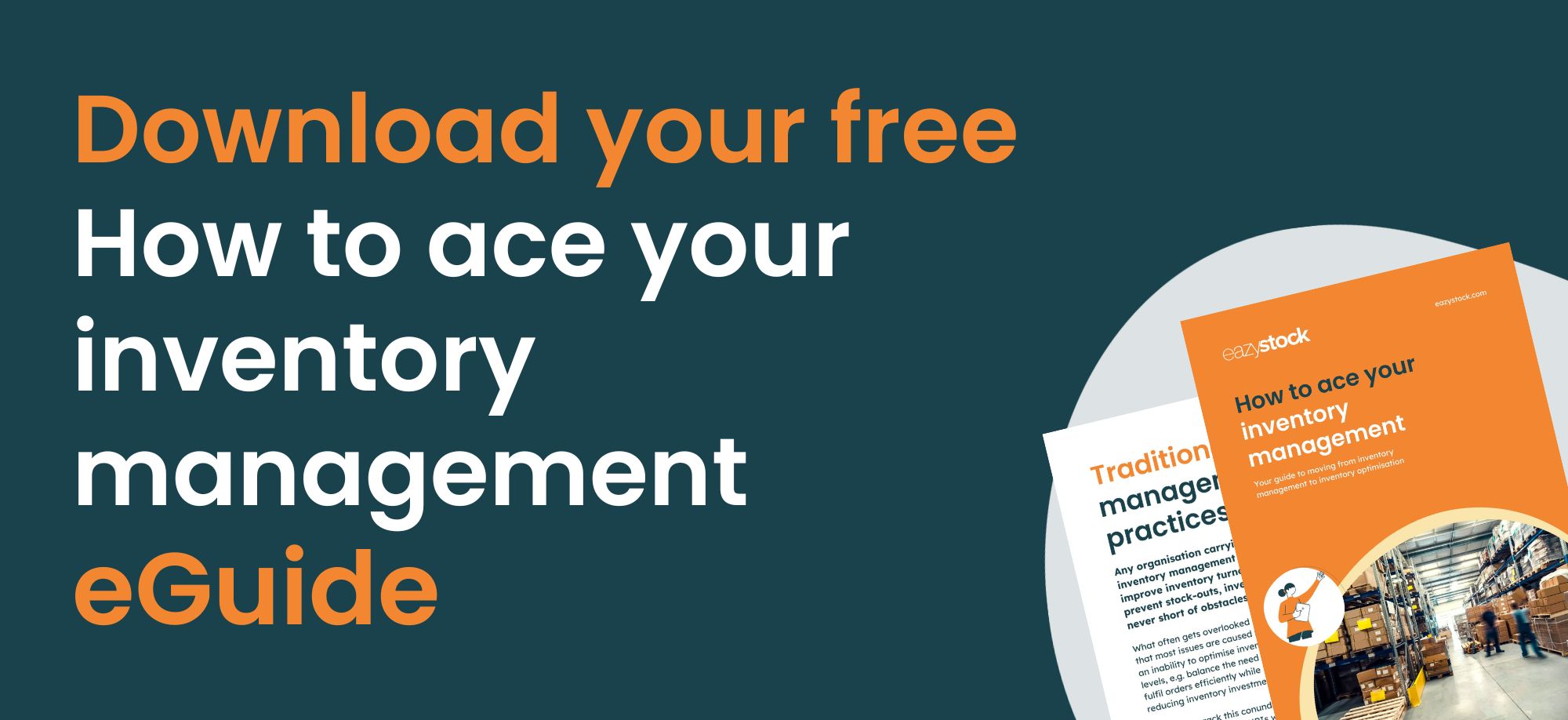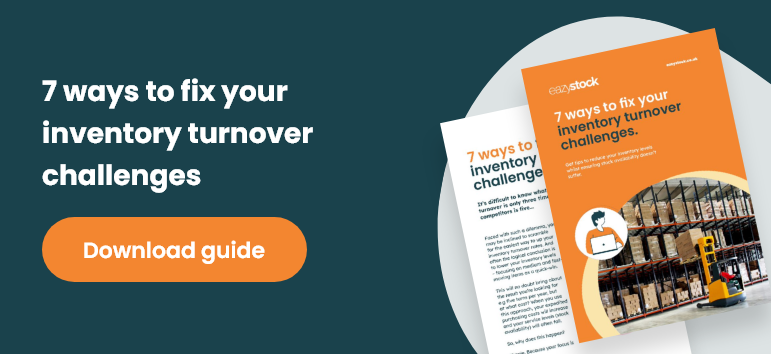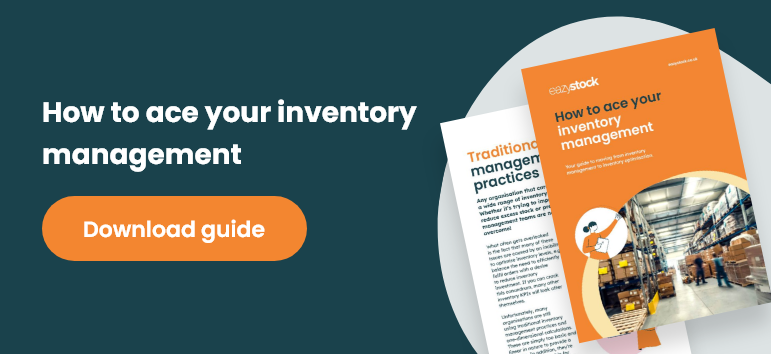How to improve inventory turnover – six simple steps
The benefits of improving your inventory turnover
If you carry a lot of stock items, you’ll likely have a significant portion of money (working capital) tied up in inventory. This can directly impact your cash flow and profitability. Improving your inventory turnover can accelerate the movement of items through your business, effectively converting your investments back into accessible cash through sales or using them in manufacturing processes. This financially rewarding strategy boosts your cash flow while enhancing your profitability.
One crucial aspect of inventory management is monitoring your inventory turnover ratio (inventory turnover rate). This metric, often called ‘stock turn’, is a fundamental indicator of your efficiency. The inventory turnover calculation measures the number of times you buy and replace (or turn) inventory relative to its cost of goods sold (COGS) over a certain period, usually a year. A high turnover ratio is usually a positive sign, indicating that you sell your inventory more frequently.

In general, a high inventory turnover ratio can improve profitability because:
- Items that turn faster have lower carrying costs.
- Cash is constantly freed up for reinvestment.
- Businesses can remain responsive to the marketplace and react to changes in demand.
- There’s less chance of excess stock becoming obsolete and being sold off at a loss.
Before looking at how to improve inventory turnover, it’s important to understand the causes of low stock turnover. Indentifying these causes allows you to address them and improve your inventory turnover. Common causes include overstocking, inaccurate demand forecasting, poor inventory classification, and inefficient order management. You can read more about the causes of low stock turnover in our blog.
Don’t get daunted by increasing inventory turnover
While increasing inventory turnover might seem daunting, it’s more achievable if you’re armed with the right strategies. Let’s explore how.
It’s not as simple as just ordering less or more frequently. Some businesses face constraints in placing and receiving more orders, often due to supplier minimum order quantities. Plus, reducing warehouse stock could lead to stockouts, resulting in lost sales and dissatisfied customers.
The key to improving your inventory turnover lies in more strategic stock management. Gaining a clear understanding of current stock levels and anticipating customer demand for your products and related future stock needs, allows you to order the optimal amounts of the right items, at the right time. Strategically taking control of your inventory management can significantly enhance your inventory turnover and improve your business’s financial health.
Here’s how to make this happen.
Six ways to improve inventory turnover
Here are six ways to improve inventory turnover without damaging stock availability:

- Know your inventory items’ position in their product life cycle
- Improve demand forecasting accuracy
- Prioritise your inventory
- Reorder smarter
- Use up excess inventory by redistributing stock
- Use automation to improve insights
Let’s look at each one in turn.
1. Know your inventory items’ position in their product life cycle
The product life cycle describes the stages a product goes through, from its introduction to the marketing until its decline. As items move through their product life cycle, their demand will change. Most items in the growth stage will experience an upward demand trend. At maturity, demand often levels off and becomes relatively steady, and during decline, it can become more erratic and then fall off. Consequently, your product portfolio will have thousands of SKUs with different demand patterns/types.
Demand types are important to improve inventory turnover (read points 2 and 3). When focused on the product life cycle, it makes sense to concentrate on items entering their decline stage. This is so you can monitor their demand more closely and devise strategies to reduce stock levels before the items become obsolete, e.g., have no demand.
Possible strategies include reducing your reorder quantities and safety stock levels. You could also use marketing campaigns or pricing tactics to increase demand and move the stock faster before your customers completely lose interest.
2. Improve demand forecasting accuracy
To improve stock turnover, purchasers should only order items with customer demand in the marketplace. Accurate demand forecasting is, therefore, critical.
Until now, you may have only used simple moving averages to calculate demand based on a certain number of stock days. However, these calculations are too simplistic to deal with today’s market demand and supply fluctuations. They can result in over-forecasting, leading to a low inventory turnover.
To improve your stock turnover, you need to go beyond these basic calculations and aim to use statistical demand forecasting principles. Firstly, you need to factor an item’s demand type based on its position in the product life cycle into your forecasts and adjust your forecasting algorithms accordingly.
Secondly, you should identify items with seasonal demand patterns and market trends and, again, fine-tune the forecast.
Thirdly, you should refine your forecasting parameters to reflect market demand volatility. For example, forecasting periods for slow-selling markets can extended and reduced if market demand is volatile.
Finally, allow for qualitative demand insights, such as adjusting forecasts for promotions or competitor activity. For instance, if you know a competitor is launching a similar product, you can adjust your forecast to account for potential shifts in demand.
3. Prioritise your stock with inventory classification
We’ve already discussed how every item in your product portfolio will have a different demand type. But, at the same time, every item will also differ in terms of their:
- Value e.g. revenue or profit margin.
- Cost to sell.
- Demand volatility.
- Pick frequency.
It, therefore, makes no sense to have one generic stocking policy where you manage every item in your portfolio in the same way. Instead, you should prioritise stock items based on the above characteristics. By classifying every inventory item, you can manage items with similar characteristics in the same way. This can optimise your inventory levels and improve your inventory turnover.
A basic form of inventory categorisation, such as ABC analysis, lets you group products based on one dimension, e.g., value, with A items being the most valuable to the business, B items less valuable and so on.
For more sophisticated inventory classification, you need to consider more variables that affect turnover rates, such as an item’s pick frequency, cost or demand. You can then produce multi-dimensional inventory stocking policies that show what items to stock and in what quantities.
By optimising inventory levels, you’ll quickly see an improvement in your inventory turnover without risking stockouts of your most important lines.
4. Reorder smarter
While placing bulk orders to get supplier discounts may be tempting, it’s wise to understand the impact this will have on your inventory turnover. Don’t forget that inventory costs money to carry and ties up working capital. And, if the items you’re buying in bulk aren’t best sellers, they could end up as excess or even obsolete stock at a significant cost to the business.
Ideally, you want to place small order quantities regularly to minimise stock turning and investment.
However, sometimes this isn’t always possible due to inefficient processes or suppliers’ ordering restrictions. In such situations, you must think smartly about how you replenish items. For example, EazyStock has an order fill-up feature that allows you to work to minimum order quantity, value or weight restrictions. So, when you need to top up an order, the system simulates the future order process (based on forecasted demand, stock levels, and orders due to be delivered) and recommends the most suitable items to add. This simulation also factors in sales trends and seasonal behaviour to ensure the stock you fill up with is the right stock.
5. Use up excess inventory by redistributing stock
You may notice that inventory turnover varies between locations with multiple warehouses. Whilst some sites may have excess stock of certain products, others may be short of the same SKU.
Therefore, it makes sense to look at your inventory as a whole, e.g., across all sites, and optimise stock levels across each location through redistribution before placing new orders. This process reduces the need to place emergency orders with suppliers (often costing more) and helps keep item counts low and lean.
6. Use automation to improve insights
Without stating the obvious, you need a good inventory management system to track your stock levels and provide an accurate base to calculate and improve inventory turnover. A warehouse management system (WMS), an inventory module of an enterprise resource planning (ERP) system or inventory management software can do this for you. A good system will calculate and monitor inventory turnover ratios down to SKU level, allowing you to identify which products are not providing an adequate ROI.
However, we recommend inventory optimisation software to optimise inventory levels and carry out sophisticated demand forecasting, inventory planning, classification, and replenishment activity.
Inventory optimisation apps, such as EazyStock, can easily be integrated with your inventory management system to provide the extra intelligence needed to increase inventory turnover without harming stock availability.
If you’d like to learn more about EazyStock, contact our team on 0121 312 2992 or request a demo.












